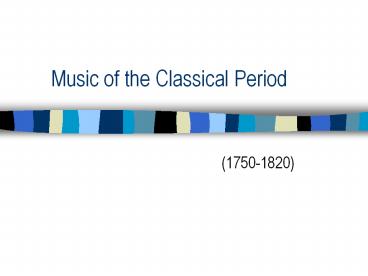Music of the Classical Period - PowerPoint PPT Presentation
Title:
Music of the Classical Period
Description:
Music of the Classical Period (1750-1820) Classical Defined A classic is any supreme accomplishment of lasting appeal (for example a movie classic or ... – PowerPoint PPT presentation
Number of Views:537
Avg rating:3.0/5.0
Title: Music of the Classical Period
1
Music of the Classical Period
- (1750-1820)
2
Classical Defined
- A classic is any supreme accomplishment of
lasting appeal (for example a movie classic or
classic rock song) - classical music (lowercase c) usually refers
to any music that is NOT rock , jazz, folk, or
popular - Classical music (uppercase C) refers to music
written between 1750-1820, which exhibits some of
the artistic ideas found in Neoclassic visual
art and architecture - In visual art and architecture, Classical Art
refers to Greek and Roman antiquity
3
Classicial Historical Highlights
- Age of Enlightenment using reason to solve
social problems - Age of violent upheavals - French American
Revolutions, Napoleonic Wars - Political power shifts from noble courts and
church to the newly empowered middle class - Composers move from high-class servants to
free-lance, self-employed artists
4
Classical Artistic Highlights
- New emphasis on balance and clarity of structure
- Neoclassic Architecture and Painting
- firm lines clear structure
- balance symmetry
- moralistic subject matter
- Greek Roman references
- Arts meant to please and entertain rather than
instruct new emphasis on naturalness pleasing
variety - Rococo artists Watteau Fragonard
5
Upper Belvedere, Vienna 1721-22
6
Temple of Love at Versailles, 1775
7
David,Mars disarmed by Venus, 1824
8
- Fragonard
- The Reader
9
Classical Music Genres
- Vocal Music Genres
- Opera
- Instrumental Music Genres
- Orchestral Music
- Symphony
- Concerto
- Chamber Music
- String Quartet
- Serenade
10
Classical Musical Highlights
- New emphasis on pleasing variety
- Highly flexible rhythms (i.e. all different
lengths of short and long notes) - More difference between musical ideas within a
single movement or piece - Introduction of crescendo and diminuendo into
varied dynamic changes - New emphasis on naturalness
- Demand for simplicity and clarity in melody and
harmony - Use of secular pop/folk tunes in art music
- More melody accompaniment (homophonic) textures
- New emphasis on morality, common people, and
everyday life in OPERA - Example
- W.A. Mozarts Act 1, Scene 1 from Don Giovanni
11
Opera
- Sung theatrical work
- Staged with costumes and sets
- Example WOLFGANG AMADEUS MOZART Act 1, excerpt
from Opening Scene from Don Giovanni
12
Classical Music Style Characteristics
Timbre End of basso continuo evolution of standard orchestra with all four choirs strings, woodwinds, brass, percussion transition from harpsichord to piano
Rhythm Emphasis on flexibiliy and naturalness unexpected pauses syncopations frequent changes from long to short note patterns
Melody Tuneful, easy to remember folk-like, often borrowed balanced and symmetrical phrase lengths tend to be rounded
Form New emphasis on symmetrical structures and clear formal designs new emphasis on rounding new emphasis on multi-movement instrumental works widespread use of Sonata form
Dynamics Widespread use of gradual dynamic changes (I.e.crescendos diminuendos) transition from harpsichord to piano
Texture Basically HOMOPHONIC MELODY ACCOMPANIMENT but flexible sudden appearances of small bits of imitative polyphony
Harmony Less dense simpler and more stretched out harmonic progressions gradual abandonment of basso continuo
Mood Emphasis on variety and contrast
13
Karlskirche, Vienna 1716-33
14
(No Transcript)
15
Petite Trianon at Versailles, 1726-68
16
(No Transcript)
17
(No Transcript)
18
Wolfgang Amadeus Mozart
19
Ludwig Van Beethoven































